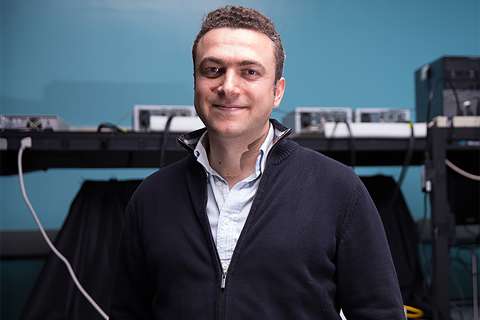In 2013, shortly after visiting a breast cancer awareness booth at the Summer X Games in downtown Los Angeles, Elisa Avalos became concerned about a lump that she had found during a home self-examination. She immediately sought medical advice at a clinic in the San Fernando Valley, but doctors there told her not to worry. “It was likely nothing, probably just fatty tissue or caused by your period,” Avalos says she was told.
That went on for more than a year, until Avalos, who was 34 at the time, discovered a second lump in her other breast, and she knew she needed another opinion.
That’s when she made an appointment at Olive View-UCLA Medical Center, in Sylmar. As she waited to speak with a doctor following her mammogram and an ultrasound, Avalos said she was feeling “cocky.”
“I was proud for having taken care of myself at such a young age,” she recalls. “But when I walked into her office and looked at the screen and at her, I knew.”
At 5 a.m. the next day, she returned to the hospital for a biopsy. That is when Avalos met her breast cancer “navigator.” From that point forward, Avalos, who was diagnosed with stage 3 aggressive breast cancer, would have an advocate who would guide her through Medi-Cal paperwork, appointments, tests and treatments, and also help her wade through the difficult emotional journey.
"The navigator is like an angel – they are there always to lift you up,” Avalos says.
Funded by UCLA’s Jonsson Comprehensive Cancer Center, Olive View-UCLA Medical Center has two full-time navigators who are dedicated to patients with breast cancer, from diagnosis through treatment. Initially created by a grant from Avon, the navigators are modeled on a program that started at New York’s Harlem Hospital Center in 1990 by Dr. Harold Freeman, a former president of the American Cancer Society, to help low-income and uninsured individuals navigate the complexities of the medical system.
Among the most common challenge that navigators face is to help patients understand their diagnosis.
“Many times when patients are given the news that they have cancer, they are in shock and don’t fully hear anything else that the doctors are explaining to them,” says Johana Alfaro, care coordinator and supervisor, who has been with the program since 2009. “We navigators understand that this is normal, and we follow up with the patient to make sure they understand their diagnosis and treatment plan. If they don’t, we reiterate what was discussed and recommended by the doctors.”

The navigators also empower patients. “Johana taught me to speak up for myself if I have questions,” Avalos says. “I can call her, and she will take the time to explain things to me. I will say, ‘Johana can you explain this to me like I’m a 2-year-old.’ She showed me the size of my lumps; instead of centimeters, she explained the sizes of a nickel, a dime and a penny, and drew them for me on a paper so I could have it for reference.”
The navigators also help patients in obtaining wigs and prosthesis.
Mirella Rodriguez, a patient navigator who initially began with the program in 2012 as a volunteer, says it is gratifying to be able to make a difference in someone’s life. “I love being involved in the care of patients,” she says. “It’s one less thing for them to worry or stress about. Once patients get to know us and understand our role, they know they can count on us for help, whether it be confirming an appointment, understanding a doctor’s visit or simply lending an ear.”
The navigators go beyond assisting with traditional medical care. When Elisa Avalos’ father died, Alfaro called to check on her. While Avalos was undergoing treatment, she taught Avalos’ children how to check her temperature and go to a neighbor’s and call 911 if it got too high. When Avalos was too worn out to cook, Alfaro arranged for meals to be delivered by a local nonprofit. At Christmas, when Avalos couldn’t get toys for her children, Alfaro took care of that, too.
Patients diagnosed with stages 0 through 3 are followed through their treatment completion; stage 4 patients are monitored until they go to hospice or pass away.
“We never abandon them,” Alfaro says.
During the COVID-19 pandemic, the navigators’ role has taken on even greater urgency to ensure proactive care.
“We worked to make sure none of our patients were lost during the pandemic,” Alfaro says. “Cancer doesn’t stop, and we had to make sure that everything that needed to be done was done in a timely manner, that nothing was being pushed back and affecting care.”
Yesica Carbajaz, 47, remembers the moment last year when she received her diagnosis of invasive ductal carcinoma. But she hadn’t revealed anything to her husband, not wanting to worry him. So, Rodriguez offered her assistance. Although visitors weren’t allowed in the hospital because of COVID restrictions, Rodriguez was able to arrange for Carbajaz’s husband, Javier Lopez, to meet them at the navigators’ office when there was no one else there so she could tell him in person.
“You don’t know how you will react,” Carbajaz says. “But I was able to be calm with Mirella there and tell my husband I have cancer. Tears were shed later. It’s such a blessing to have her. She helped me then, and she continues to help me now.”
Learn more about UCLA's Jonsson Comprehensive Cancer Center.
Marina Dundjerski is the author of this article.



